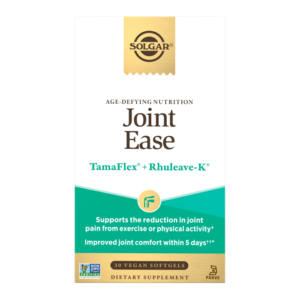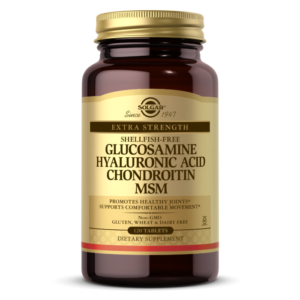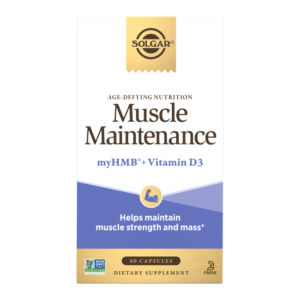Key Takeaways:
- You can support healthy hip joints by building the muscles around your joints and eating an anti-inflammatory diet.
- Supporting your bone health, sitting less, or taking a joint health supplement such as Joint Ease can also help support healthy joints as you age.*
You may not think about your hip joints often, but they are an important part of your body. Your hip joints help you stand, sit, walk, and bend. But as you age, they may feel stiff or cause occasional discomfort.
The good news? There’s a lot you can do to support healthy, mobile, and strong hip joints as you age. But first, let’s take a look at why hip joints change with age.
How do hips age?
The hip joint is a ball-and-socket joint. It’s made up of your hip bone (pelvis) and your thigh bone (femur), and has many muscles and ligaments keeping it in place.
Three things help healthy joints move smoothly and comfortably: cartilage, synovial membranes, and lubricating fluid (synovial fluid). However, joint movement may become stiffer and less flexible as you age, because the amount of lubricating fluid inside your joints decreases and cartilage becomes thinner.1
Let’s look at a few science-backed ways to support healthy hip joints.
1. Focus on strengthening your muscles
If you feel occasional discomfort in your hip joints, your instinct may be to try hip flexor stretches. And while stretching has important mobility benefits, you shouldn’t overlook the importance of strengthening the muscles around your hips first.
Your hip joints are surrounded by muscles that help hold them in place. By strengthening the muscles that support these joints, you help take the load off the joints themselves and put some of it on the muscles.
Which muscles should you target for strong hips?
Any muscle attached to or surrounding the hip joints is important to strengthen. This includes the glute muscles, the psoas muscles (deep core muscles that connect your pelvis to your spine), the hamstrings, and the inner thigh muscles.

Exercises for strengthening your hips
Try these exercises to strengthen your hip flexors, but remember to consult your doctor before starting a new exercise routine.
Standing Hip Flexor Marches
How to do it:
- Stand up straight with your feet hip-width apart.
- Engage your core and lift your right knee toward your chest, aiming to bring it to hip level.
- Lower your right leg and repeat with your left leg, mimicking a marching motion.
- Continue alternating legs for 12–15 repetitions.

Seated Leg Lifts
How to do it:
- Sit on the edge of a sturdy chair or bench with your back straight and feet flat on the floor.
- Extend your right leg straight out in front of you.
- Keeping your leg straight, lift it as high as you can without rounding your back.
- Hold for a second at the top, then slowly lower your leg back down.
- Repeat for 12–15 repetitions, then switch to your left leg.

Squats
How to do it:
- Start in a standing position with feet slightly spread apart and arms to the side.
- Bend the knees and push the buttocks toward the back.
- Drop down until the legs are roughly parallel to the floor, keeping knees in line with the feet.
- Keep your core tight and then raise back to standing position
- Repeat 12–15 repetitions. To add extra challenge, add in jumps or weights.

Supplement for maintaining muscle strength*

Solgar® Muscle Maintenance
Muscle Maintenance is uniquely formulated to support muscle mass* and helps:
- Preserve lean muscle tissue*
- Support recovery after intense exercise*
- Maintain muscle strength and mass*
- Support muscle function in older adults*
- Support muscle mass*
2. Add more whole foods to your diet
What you eat affects every aspect of your health — including your joints. Foods rich in omega-3 fatty acids and other nutrient-dense whole foods can help support healthy joints.2 Try adding some of these foods to your next meal for added joint support:
- Tomatoes
- Olive oil
- Green leafy vegetables, such as spinach, kale, and collards
- Nuts like almonds and walnuts
- Fatty fish like salmon, mackerel, tuna, and sardines
- Fruits such as strawberries, blueberries, cherries, and oranges
3. Take a supplement for joint health
Exercise and eating a balanced diet are foundational steps to supporting hip joint health, but taking a supplement is another easy way to give your joints the support they deserve.
Here are a few of our favorite supplements for joint health:*

Solgar® Joint Ease
Solgar® Joint Ease is uniquely formulated with clinically-studied ingredients to support joint health.* With continued use, just one softgel daily helps:
- Support the reduction in joint pain from exercise or physical activity*
- Improve joint comfort within 5 days✝✝*
- Improve joint health, stiffness, range of motion, and/or mobility*
- Support a healthy inflammatory response✝*
Solgar® Glucosamine Hyaluronic Acid Chondroitin MSM
- Supports mobility, range of motion and flexibility*
- Eases occasional joint stress due to exercise or physical activity*
- Supports cartilage and joint function*
- Promotes joint comfort*
This formula also includes hyaluronic acid, an ingredient that helps support joint health.*
4. Don’t forget about your bone health
Bone health is fundamental to maintaining healthy joints. Throughout your life, your body is continually engaging in a process called remodeling, during which old bone is removed and replaced with new, fresh bone. Up until about the age of 40, all bone is replaced. After age 40, however, less bone is replaced over time.5
Thankfully, taking a supplement can help support bone health as you age.
Read more: What Women Need to Know About Bone Remodeling
Supplements for bone health
Solgar® Liquid Calcium Magnesium with Vitamin D3
Solgar® Liquid Calcium Magnesium with Vitamin D3 offers three nutrients for promoting bone health in one easy, liquid supplement.* The liquid form makes it easy to take, and each serving supports strong bones and teeth, helps maintain a healthy immune system, and helps maintain proper nerve and muscle function.* Available in strawberry, blueberry, and orange-vanilla flavors.
5. Sit less, move more
With long commutes, desk jobs, and more and more time spent in front of a screen, many people spend most of their day sitting. However, excessive or prolonged sitting can put stress on your hip joints and can lead to stress on your lower back, reduced spine flexibility, and more.6
While you can’t always control how much of your day you spend sitting, try to get up and move around every hour. You can also try incorporating simple hip stretches, such as lunges, pigeon pose, or leg swings.
GET THE LATEST UPDATES AND EXCLUSIVE DEALS WHEN YOU SIGN UP FOR OUR NEWSLETTER!
Summing it up
The sooner you start prioritizing your hip joint health, the better. Exercising regularly, eating a healthy diet, trying to reduce the time you spend sitting, and taking a joint, muscle, or bone health supplement can help support healthy joints as you age.*
Want easy tips on staying healthy? Follow us on TikTok! (@solgarvitamins)
* These statements have not been evaluated by the Food and Drug Administration. These products are not intended to diagnose, treat, cure or prevent any disease.
✝✝ Based on a double-blind, placebo-controlled trial with TamaFlex® where joint comfort improved within 5 days and continued to improve throughout duration of the study.
✝ Inflammatory response in our body can occur from a variety of everyday factors such as exercise, daily activities, physical exertion, and other lifestyle factors.
The information provided on this site is intended for your general knowledge only and is not a substitute for professional medical advice or treatment for specific medical conditions. Always seek the advice of your physician or other qualified healthcare provider with any questions you may have regarding a medical condition. The information on this website is not intended to diagnose, treat, cure or prevent any disease. Never disregard medical advice or delay in seeking it because of something you have read on the Solgar® site.





